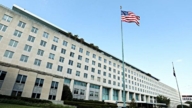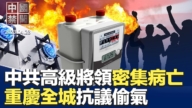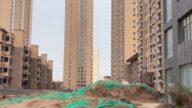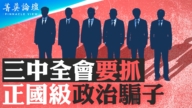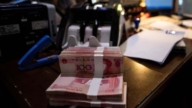【新唐人2014年11月24日訊】日前,國際評級機構:標準普爾對中國的房地產、地方政府、銀行等多個領域進行了評級,結果地方政府半數被評為「垃圾級」。專家指出,標準普爾的評估來源於中共公布的數據,由於這些數據水分很大,因此實際現狀應該更差,不過這些評級結果已經足以讓國際機構加快撤資、逃離中國。
國際評級機構標準普爾(S&P)11月20號發佈一份報告,對中國多方面經濟進行了評估。根據標準普爾的說法,中國大約一半的地方政府應授予「垃圾級」的信用評級,而中國企業信貸狀況出現分化,銀行業的經濟風險也比較高,尤其對中國房價過高,樓市供應過剩提出了警告。
美國南卡羅萊納大學艾肯商學院終身教授謝田:「一兩年前我們都指出過,這些問題現在不光是越來越明朗化,也越來越被西方的評級機構和金融業所認識到,認識到這些問題之後,下一步動作,一個做空,一個撤資會越來越加劇。」
在對中國地方政府的評級中,標準普爾的分析暗示,31個被調查的中國地方政府中,15個應評為「垃圾級」,尤其東北的表現最差,東北三個省份中有兩個出現了「投機級信用特徵」。而中西部省份中,近半數出現了垃圾債券特徵。
清華大學經濟學教授楊斌:「甚至一半還多,因為有很多假象,還高估了。」
據大陸媒體報導,此前中共已經採取切割政府債務和企業債務的方式,將至少14萬億政府債務轉為企業債務,並且正在籌劃,將這些債務證券化,上市兜售。
《金融時報》評論指出,標準普爾的評級,可能會對中共中央政府發展市政債券市場的努力,造成打擊。
謝田:「實際上也都是垃圾債券,但是肯定它還會繼續發,中國的老百姓可能還會繼續買,因為中國也搞了一些自己虛假的評級機構,它會給它非常好的評級來欺騙中國的百姓,而中國百姓可能還有另外一個僥倖心理,覺得中共在掌權,它不會讓這些地方債違約或破產。」
而標準普爾的一份名為《銀行業國家風險評估:中國》的報告中說,中國較低的人均GDP限制了經濟發展的彈性。
楊斌:「80%的人消費比較低,收入比較低,更嚴重的限制了中國的彈性,80%的人平均儲蓄不到一萬元,怎麼去拉動消費,還沒有社保,他不敢花,一生產就過剩,一生產就過剩嘛,循環不起來。」
報告中還說,中國銀行業的經濟風險也比較高,而信貸的快速擴張又帶來了經濟失衡的高風險,以及經濟中較高的信貸風險。
楊斌:「作為銀行來說沒甚麼風險,作為老百姓來說風險比較大,通貨膨脹比較厲害,嚴重的時候,投資回報還抵不上通貨膨脹。」
在行業風險方面,標準普爾認為,銀行業普遍的國有產權,以及對存款利率的行政控制,阻礙了銀行業的動態競爭。
謝田:「不光壟斷了利率,實際上用這個辦法在壓低利率,也在壓低匯率,通過各種方法來盤剝中國老百姓,讓老百姓不得不把錢存在中共國有銀行裡邊,不得不讓他們的存款大幅度的縮水。」
另外,標準普爾的評級結果顯示,雖然中國企業信貸狀況惡化的程度有所減輕,但企業間的競爭,和產能過剩是一個很大的難題。而企業的債務主要集中在鐵路、地鐵和公共事業,這些行業又與政府的政策息息相關。
同時標準普爾還對中國的房地產業發出了警告,報告稱中國房地產市場評級,可能比亞洲其他大型市場受到的衝擊更大。而房地產市場定價過高,加上供應過剩,預計中國和香港的房價面臨下滑。
由於房地產業,佔中國年度經濟產出的比重超過15%,而銀行業為建房和購房提供大量融資,房地產市場長期低迷,反過來又是中國經濟面臨的最大風險。
採訪編輯/劉惠
S&P Finds Half of Communist Local Governments
Deserve Junk Ratings.
New analysis on China by Standard & Poor’s (S&P) saw low
performance in real estate, local governments, banks etc..
Half of the local governments may warrant
junk-level credit ratings.
Experts indicate the actual situation will be worse since the
analysis was based on data alleged by local governments.
However, this rating is sufficient to have international
agencies short China, accelerate the divestment and flee.
The S&P analysis of China credit on Nov. 20 suggested about
half of China’s local governments deserve junk-level ratings.
According to a FT report, warnings are suggested over the
diverging credit profiles in the corporate sector.
This is amid the high risks in the banking
and real estate bubbles.
Professor Frank Xie, University of South Carolina Aiken
School of Business, “We pointed this out two years ago.
It is now becoming more clear and recognizable by the
Western analytical agencies and financial sectors.
Their next step will be to short China
and increase divestment."
The S&P analysis found 15 of the 31 localities surveyed to
be worthy of junk status.
Northeast China fared the worst in the analysis.
Two of the three provinces in Northeast China had what it
called “speculative-grade credit features."
Half of the Midwest provinces deserved “junk" ratings.
Yang Bin, economics professor at Tsinghua University, “It
should be more than half, since many were covered up
by illusion. It is overrated."
According to mainland media reports, the regime has
separated local government debts from corporate debts.
At least 14 trillion yuan of government debts have been
transitioned into corporate debts.
These debts will be peddled through issuing of securities.
According to the FT, S&P bashes China’s local-governmental
effort in developing the municipal bond market.
Professor Frank Xie, “The bonds must be junk as well.
Under the false rating from the Chinese agencies, Chinese
people are likely to be deceived and buy those bonds.
The people might be willing to take chances believing that
under the ruling of the Chinese Communist Party (CCP),
no default or bankruptcy would happen."
In the report titled, Banking Industry Country Risk
Assessment: China, S&P stated that the country’s
low per capita GDP constrains its economic resilience.
Yang Bin, “The flexibility of China is very seriously limited
by 80% of the population having a relatively low
consumption rate and low income.
With less than 10,000 yuan of average savings (about
US$1,631) and no social security for 80% of the population,
how can the consumption be stimulated? They would not
dare to spend the money.
Any production will only result in surplus. It is a cycle."
S&P also said in the report, rapid credit expansion has led to
high risks of economic imbalances and elevated credit risks
in the economy.
Yang Bin,"There is not much risk to banks, but relatively high
risk to the ordinary people.
When inflation is severe, the return on investment
can’t make up the difference from inflation."
In terms of industry risk, prevalent state ownership and
administrative control of deposit rates challenge the banking
sector’s competitive dynamics, reported the S&P.
Frank Xie, “It is not just the interest rate, in fact,
it lowers the interest rates and the exchange rates.
Through various exploitations, the Chinese have to save
the money in the state owned banks and tolerate the
huge depreciation of their deposits."
S&P’s ratings also showed that, the credit deterioration
of Chinese enterprises may been reduced, but competition
between enterprises and overcapacity are major problems.
The enterprise debts have focused on rail, subway and public
utilities, the ones closely linked with the government’s policy.
S&P also warned in the property report, China’s over-priced
and over-supplied property market are likely to result in
Chinese and Hong Kong house prices falling in coming years.
Reuters reported, the property sector accounts for more
than 15 percent of China’s annual economic output;
Banks provide much of the financing for building and buying,
so a prolonged downturn poses possibly the biggest risk
to the world’s second-largest economy.
Interview & Edit/LiuHui



